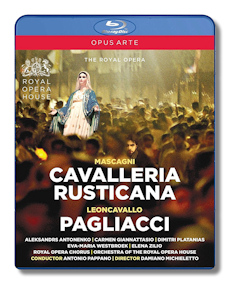
The Internet's Premier Classical Music Source
Related Links
-
Leoncavallo Reviews
Mascagni Reviews - Latest Reviews
- More Reviews
-
By Composer
-
Collections
DVD & Blu-ray
Books
Concert Reviews
Articles/Interviews
Software
Audio
Search Amazon
Recommended Links
Site News
 Blu-ray Review
Blu-ray Review
Operas Intertwined

Pietro Mascagni
Cavalleria Rusticana
- Eva-Maria Westbroek - Santuzza
- Aleksandrs Antonenko - Turiddu
- Elena Zilio - Mamma Lucia
- Dimitri Platanias - Alfio
- Martina Belli - Lola
Ruggero Leoncavallo
Pagliacci
- Dimitri Platanias - Tonio
- Aleksandrs Antonenko - Canio
- Carmen Giannattasio - Nedda
- Beppe - Benjamin Hulett
- Silvio - Dionysios Sourbis
- Two Villagers - Elliott Goldie, Nigel Cliffe
Royal Opera Chorus & Orchestra of the Royal Opera House/Antonio Pappano
Stage Director - Damiano Michieletto
Set Designer - Paolo Fantin
Costume Designer - Carla Teti
Lighting Designer - Alessando Carletti
Recorded live at the Royal Opera House, Covent Garden - December, 2015
Bonus Features - Introduction to Cavalleria Rusticana & Introduction to Pagliacci; Antonio Pappano talks about the music; Cast Gallery
Opus Arte Blu-ray OABD7200D 2Discs 74:50 (Cavalleria); 78:04 (Pagliacci); 15:52 (Bonus) PCM Stereo DTS-HD Master Audio Dolby Atmos
Also available on DVD OA1210D: Amazon - UK - Germany - Canada - France - Japan
As most opera mavens are well aware, Cavalleria Rusticana and Pagliacci have been performed together on the same bill for more than a century. True, they are sometimes staged separately as well, but more often than not, on recordings and in the opera house they are treated like inseparable twins. Here that status is taken a step further, as Stage Director Damiano Michieletto links the two works by having characters from each opera appear in the other. During the Cavalleria interlude Nedda and Silvio meet to begin their affair, while during the Pagliacci intermezzo Santuzza, grieving over the loss of Turridu but comforted by a priest through Confession, reconciles with Mama Lucia, her lover's mother. Also, promotional posters for Pagliacci are seen hanging on the walls in Cavalleria. In a sense, these scenes are cleverly imagined because they emphasize the link between the two operas in their similar plots, styles, short duration and in their connected status in the opera world.
On the other hand, the linking process is not necessarily a total success, because it adds plot elements that arguably don't enhance the artistic yield of either opera. Moreover, you won't recognize Nedda and Silvio as significant characters when they appear in Cavalleria until you see them in Pagliacci and remember their isolated encounter in Cavalleria. True, they kiss standing beneath posters of Pagliacci, which suggests their connection to that story, but many if not most viewers will not immediately make the connection. Another, perhaps rather minor matter, is that the Pagliacci posters on the walls of Mama Lucia's bakery in Cavalleria strike you somewhat in the manner of an inside joke that isn't so "inside" but rather obvious. Still, this linking device is certainly not a major flaw, even if the characters' actions can be a distraction during the interlude and intermezzo of the respective operas. One aspect of this production that I found very effective and imaginative is the flash forward at the beginning of Cavalleria, giving the viewer a glimpse of the tragedy that will follow. Indeed, and mostly everything else in the productions is most effective as well.
The operas are set in modern-day Southern Italy, presumably in small towns. For some, updating the stories to current day might seem slightly at odds with the plentiful religious and moral aspects in both productions, as they would arguably be more appropriate for an earlier time: note the grand Easter procession in Cavalleria where a statue of the Blessed Virgin comes to life and directs an accusatory finger at Santuzza because of her affair with Turridu. Yes, the mores and religiosity might seem a bit anachronistic but we must remember Italy is home to the Vatican and obviously religion and traditional morality are still a major factor in the lives of many of the people there.
As for the performances, the singers are uniformly excellent. I must single out Aleksandrs Antonenko as Turridu in Cavalleria and Canio in Pagliacci. He delivers a knock-out Vesti la giubba in Pagliacci, and his singing in the closing scene of Cavalleria (Mamma, quel vino e generoso) is filled with passion and delivered in such attractive, robust tones. Eva-Maria Westbroek must also receive high praise here for her portrayal of Santuzza: try her intense account of Voi lo sapete, O Mama. Carmen Giannattasio is a most effective Nedda and the remaining members of the cast in both operas are also quite fine. Sir Antonio Pappano draws excellent performances from the orchestra and chorus, though the off-stage choral singing may at times be a little too distant to fit properly into the sonic perspective. I strongly favor Pappano's tempos here, which tend to be moderate to slightly on the slightly on the leisurely side, though not nearly as leisurely as the timings given in the heading above, as they take curtain calls and closing credits into account.
I've reviewed video performances of both operas here in 2012 (Arthaus Musik DVD 107331), with Domingo as Canio in Pagliacci and a mostly little known cast in Cavalleria. They were separate recordings on different labels and both were quite fine. However, the Domingo was recorded in 1997 and its video quality can't compare with that of newer recordings. I can say this new Blu-ray coupling of Cav and Pag from Opus Arte would be my first recommendation for potential buyers, especially those wanting these two operas in one package. I should mention also that there are interesting bonus features on each disc that contain commentary on the operas by conductor Pappano, stage director Michieletto, and cast members. Highly recommended!
Copyright © 2017, Robert Cummings


















